Uyghur Music
UYGHUR MUSIC SAMPLER (mp3 files courtesy of Ozgun)(Click on Thumbnails for high resolution Images. NOTE: Some high res. images may be several MB!)

Picture Courtesy: Uyghur Canadian Association
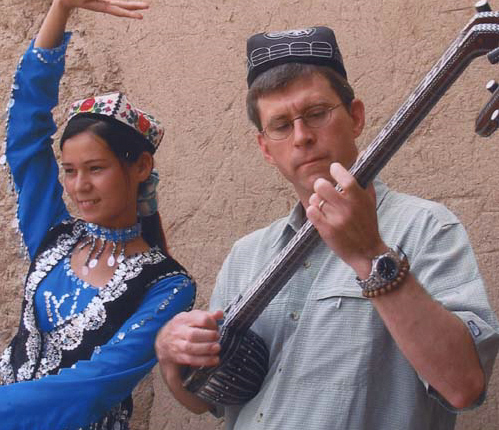
Photo Courtesy: James Millward
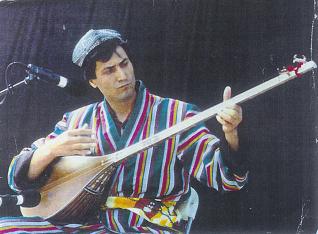
Photo Courtesy: ETNFC Organization

Photo Courtesy: Radio Compound Eye
Uyghur music embraces several distinct regional styles, product of the geography and complex history of the region, whose oasis kingdoms, separated by mountains and deserts, have been subject through the course of history to rule by many different outside forces. The musical traditions of the southern oasis towns of Khotan and Kashgar are more closely allied to the classical Central Asian traditions of Bukhara and Samarkand, while the music of the easternmost oasis town of Qumul has closer links to the music of Northwest China. Each of the region's oasis towns have to this day maintained their own distinctive sound and repertoire, but they are linked by a common language and overarching culture, maintained by constant communication through trade and movement of peoples. Musically there is much to link these local traditions, in terms of instruments, genres, styles and contexts.
The most prestigious and well-known genre of Uyghur music is the muqam, the large-scale suites of sung, instrumental and dance music. In addition to the muqam the Uyghurs maintain popular traditions of sung epic tales (dastan) and other forms of narrative song (qoshaq, l�p�r, �ytshish and m�ddhi nam�); suites of dance music (s�n�m); instrumental music; musical genres linked to the ceremonies of the Sufis, and a huge repertoire of folksongs which commonly dwell on the suffering of life on earth and the torments of frustrated love. Contrary to the common perception of Islam in the West as hostile to music, amongst the Uyghurs many traditional musical contexts are linked to the religion, largely due to the influence of the Sufis who use music to express and promote their faith. Today these traditional genres compete with a lively pop music industry and the music of the professional, state-sponsored troupes.
Some of the principal Uyghur musical instruments (see also images above this section):
Dutar
A long-necked plucked lute with two nylon (formerly silk) strings tuned a fifth or sometimes a fourth apart, with seventeen chromatic frets. The dutar is beautifully decorated, like all Uyghur lutes, with settings in horn or bone. It is used to accompany folksongs, and as a supporting instrument in the muqam. A dutar can be found in almost every Uyghur home, and is the sole instrument which Uyghur women have traditionally played. It is played glissando, mainly on the upper string but with some heterophony from the thumb on the lower string.
T�mb�r
The longest of the Uyghur lutes at around 150cm, the t�mb�r has five metal strings tuned so-so-do-so-so. The melody is played on the double right-hand strings, using a metal pick (nakh�la) on the index finger. The t�mb�r is sometimes used as principal instrument in the muqam, as well as for folksongs, narrative songs and instrumental pieces.
Rawap
The shorter lute, plucked with a horn plectrum. Several different types are played by the Uyghurs. The Kashgar rawap, at around 90cm, has a small bowl-shaped body covered with skin and five metal strings, and is decorated with ornamental horns (m�ng�z). The shorter herder's rawap (qoychi rawap), found in the Khotan region, measures around 70cm and is strung with two paired or three sheep-gut strings. Both of these types are played by the narrative singers (dastanchi and qoshaqchi). The Dolan rawap, principal instrument in the Dolan muqam, with one melodic and several sympathetic strings and pear-shaped body, ressembles the Afghan rubab more closely than the Kashgar rawap. The Qumul rawap is similiar to the Dolan version, and used in folksongs and the Qumul muqam. The Kashgar rawap has more recently become a professional virtuoso solo and orchestral instrument (t�k�mmul rawap) with six metal strings tuned do-do-so-re-la-mi. An equivalent bass rawap has also been added to professional orchestras.
Qalun
A smaller dulcimer, plucked with a bone pick held in the left hand, while the right hand presses on the string with a bronze key (gustap) to produce quarter tones and ornaments. The qalun is found more commonly in southern Xinjiang, especially amongst the Dolan. It plays a supporting role in the muqam.
Satar
A long-necked bowed lute with one melodic and eight to twelve sympathetic metal strings. The satar plays an important role in the muqam, usually played by the lead singer (muqamchi). Its sympathetic strings may be tuned in five different ways depending on the mode of the muqam being played.
Ghij�k
A fiddle with a soundboard of stretched skin. The largest of the Uyghur ghij�ks is found amongst the Dolan, with one horse-hair melodic string and several metal sympathetic strings. The Qumul ghij�k has two bowed strings tuned a fifth apart, and six to eight sympathetic strings. The earliest Chinese historical records relate that a bowed instrument strung with horse-hair was played in the Qumul region, but the contemporary instrument is probably a fairly recent hybrid between the Chinese erhu fiddle and the Uyghur ghij�k, testament to the Chinese cultural influence in this easternmost point of Xinjiang. The ghij�k now played by professional musicians was adapted in the 1950s, today its four metal strings are tuned like the violin but its playing technique is closer to the Iranian spike fiddle, held on the knee, the bow is held loosely in the hand, palm upwards, and the strings are pressed against the bow by pivoting the instrument. This ghij�k is also found in soprano and tenor versions.
Khushtar[1],
[2]
Now a prominent instrument in the professional troupes, the khushtar viol was developed in the 1960s, modelled in its shape on instruments depicted in Xinjiang's early Buddhist cave murals. It is tuned and bowed like the professional ghij�k, but its tone is lower and softer, since the whole instrument is made of wood. It is also found in soprano and tenor versions.
Dap
A frame drum, of which two types are current. The smaller n�ghm� d�pi, at around 25-30 cm in diameter, is a virtually indispensable instrument for the muqam, playing a leading role in the instrumental sections (m�rghul). The larger chong dap is used in other folk contexts, it may be used to accompany other instruments or may be played solo. The third and largest type, thought to have magic powers, is used in the healing rituals of the Uyghur shamans (baqshi or pirghun).
Naghra and other percussion instruments
Always played with the sunay, these are a pair of cast iron small kettle drums covered with cow or donkey skin laced over the body, played with a pair of sticks. The naghra-sunay group usually consists of one sunay player, with at least two and up to eleven sets of naghra which play complex rhythmic variations, with a large chong naghra maintaining the basic rhythmic cycle. Other percussion instruments include the sapay� - paired sticks pierced with metal rings, the most common folk percussion instrument, especially used by beggars and Sufis; the tash - four stones, two held in each hand, struck repeatedly and quickly together, and the qoshuq - two wooden spoons struck together back-to-back.
Sunay
A small double-reed shawm, its conical wooden body has seven front holes and one thumb hole. It has a metal bell and metal mouthpiece. It is played using circular breathing, and has a range of over two octaves.
Duduk or Balaman
A short double-reed vertical reed pipe with seven finger holes, tuned by a cross-piece of reed fixed near the mouth end of the instrument. The balaman is now found only in the Khotan region, where it is used as a lead instrument in the muqam.
N�y
Found in the folk and professional contexts, traditionally the Uyghur n�y was a long horizontal flute made of walnut wood, with a soft tone. In recent years the Uyghurs have adapted the Chinese bamboo horizontal flute.
In addition to these contemporary instruments, instruments historically used by the Uyghurs include the ghunqa - a form of harp, the b�rbap lute - ancestor of the Chinese pipa, the jalla - a bronze skin-covered tambourine, the sapal chora ocarina, and the isqirt slide flute.
References:
Music of the Uyghurs - Rachael HarrisUygur Music - Uygur World
Xinjiang, P.R.C. page: Radio Compound Eye
Uyghur Dance
(Click on Thumbnails for high resolution Images. NOTE: Some high res. images may be several MB!)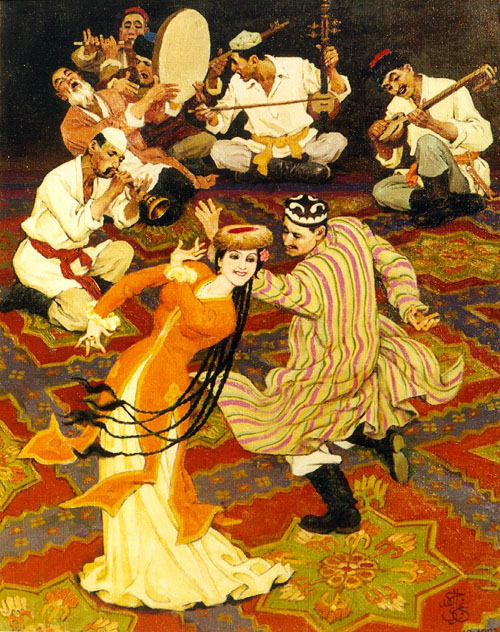
Picture Courtesy: Meshrep
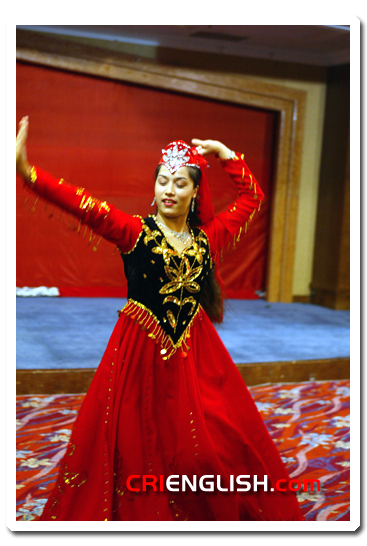
Photo Courtesy: China Broadcast Company
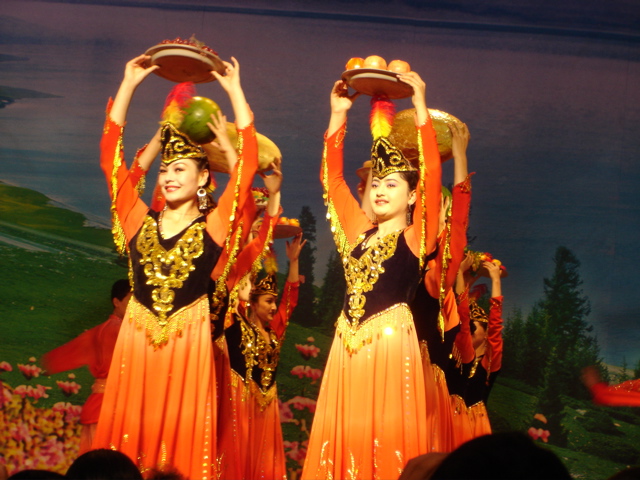
Photo Courtesy: William Coles
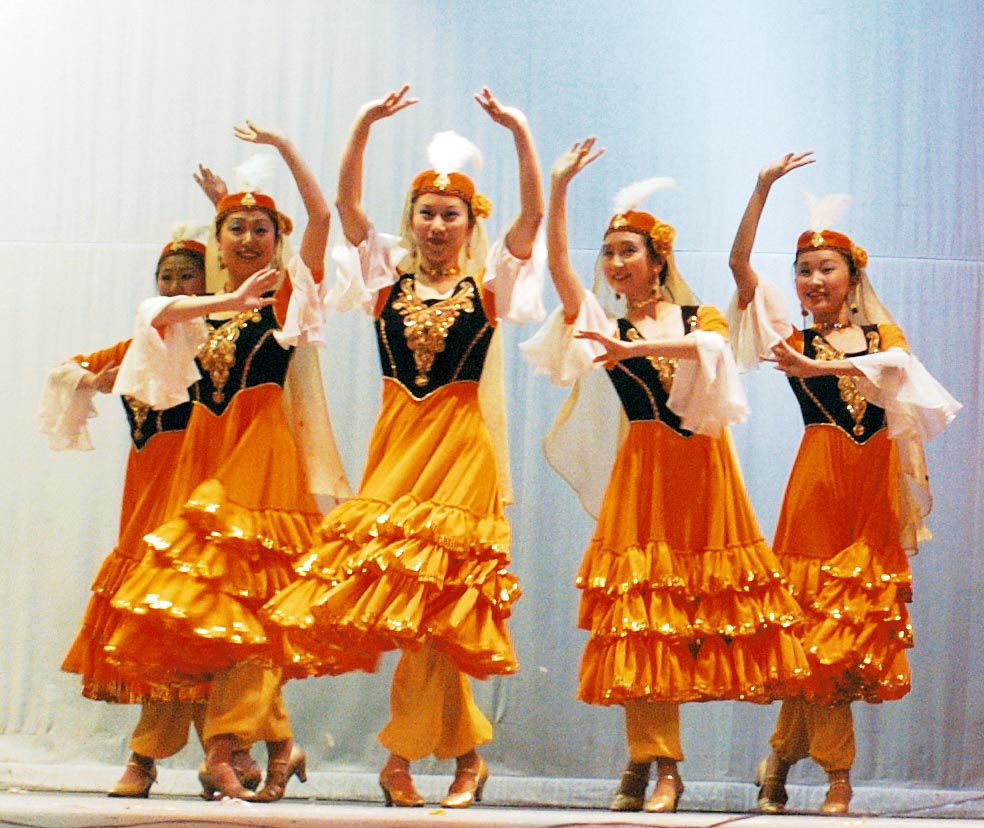
Photo Courtesy: Hua Sha Chinese Dance Center
The Uygurs have a great love of singing and dancing. Their dances are lively and reflect bravery, openness, happiness and above all, optimism. For the Uygur dancing to music is a way of life. Their dances are all about posture, position, wrist and hand movement. Coordination is the key to the dancers beauty and posture to it's sense of importance. Turns are important parts of the dance. The dancers turn fast and then suddenly stop. All the dances have their own distinct turns and the climax of any dance is the increasing tempo of the turns as if each dancer is trying to out do the others. Uygur folk dances also incorporate "shimmering". There is a rhythmic and continuous shimmering of the knees and a short shimmer when a step is changed.
Sanam(Sainaimu)
In a performance of Sanam people sit in a circle with a band in one corner. As people clap their hands and sing in unison, the dancers dance. Besides singing the familiar old songs, they improvise new verses to old melodies to describe the festive scene and their joyous feelings. The dancers also improvise, following the tempo of the music. One, two, three or five people dance together. The tempo quickens gradually until music and dance reach their climax and people shout, "Kai-na! (Come on!)" or "Balikaleila! (Wonderful!)" The shouting, drumming and music create great excitement.
Dolan
They sit in a circle while the dancers perform Dolan in the centre. First, some people sing a prelude, then while the drummers beat the drums vigorously, people rise to their feet to choose partners and start the dance (men and women usually dance separately). As the beat quickens, the dance becomes more exciting. Sometimes the couples touch at the shoulders, then separate like a whirlwind. The two dancers spin facing each other, then separate to vie with each other in a stunning display of turns. Finally one person remains, spinning to right and left as the spectators clap, raise their thumbs and shout, "Wu si ta! (Skilled dancer!)" The dance comes to an exciting and exuberant end.
Xadiyana
Xadiyana is free and lively in form with no limit as to number of participants. It is characterized by light movements and unconventional formations. Everybody dances freely according to his own inclination, hopping lightly on alternate feet. The hand movements are also very simple. Usually the dancer raises his arms high and revolves his palms quickly.
Nazirkom
Nazirkom is usually performed by men in couples in an improvisational way. The performers do not sing but dance to the singing of the band and other people. When the performance begins, the dancers display their own skills separately. As the tempo quickens, a contest of skills starts. First, two people display customary feats, one mimicking the other's movements and both dancing in fine teamwork. Suddenly one dancer presents a new and difficult movement to challenge his partner who not only follows but creates something else that is new. The spectators cheer on the performers to the rhythm of the drums. Sometimes a silk flower or handkerchief is placed on the ground for the performers to pick up. One performer will challenge the other with particularly difficult manoeuvres to pick it up. The performance reaches it's climax and conclusion at this point amid people's cheers.
References:
Uygur Dance - Uygur WorldUygur Dances - China Vista
Uyghur Arts & Crafts
(Click on Thumbnails for high resolution Images. NOTE: Some high res. images may be several MB!)The Uygur people for centuries have been fine craftsmen creating and selling their wares to the travellers and traders of the Silk Road and lately to the influx of overseas tourists. Any traveller to Kashgar will be amazed by the variety and beauty of the hand craft of the Uygur. The main types of hand craft are: skull caps, rugs, carpets, Yengsiar knives, red copper ware, woodblock printed cloth and calico, earthenware, jade and woodworking. Please check the references below for more details.
References:
Uygur Crafts - Uygur WorldUygur Arts & Sculpture - Uygur World
Please e-mail Ravi Kanda if you have any suggestions, comments or corrections.
